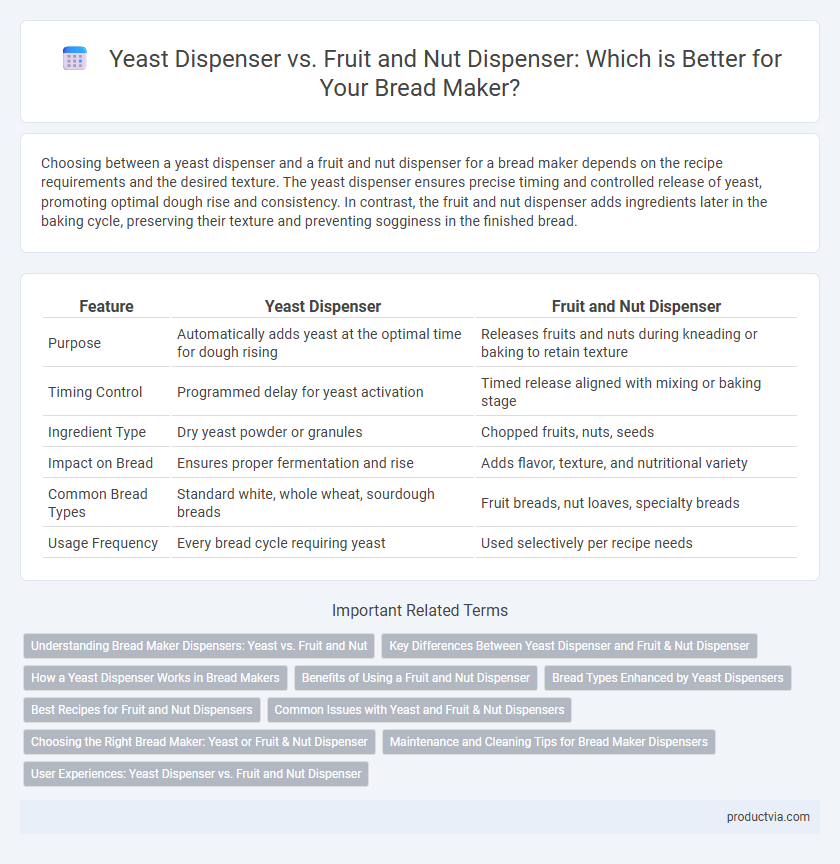Choosing between a yeast dispenser and a fruit and nut dispenser for a bread maker depends on the recipe requirements and the desired texture. The yeast dispenser ensures precise timing and controlled release of yeast, promoting optimal dough rise and consistency. In contrast, the fruit and nut dispenser adds ingredients later in the baking cycle, preserving their texture and preventing sogginess in the finished bread.
Table of Comparison
| Feature | Yeast Dispenser | Fruit and Nut Dispenser |
|---|---|---|
| Purpose | Automatically adds yeast at the optimal time for dough rising | Releases fruits and nuts during kneading or baking to retain texture |
| Timing Control | Programmed delay for yeast activation | Timed release aligned with mixing or baking stage |
| Ingredient Type | Dry yeast powder or granules | Chopped fruits, nuts, seeds |
| Impact on Bread | Ensures proper fermentation and rise | Adds flavor, texture, and nutritional variety |
| Common Bread Types | Standard white, whole wheat, sourdough breads | Fruit breads, nut loaves, specialty breads |
| Usage Frequency | Every bread cycle requiring yeast | Used selectively per recipe needs |
Understanding Bread Maker Dispensers: Yeast vs. Fruit and Nut
Yeast dispensers in bread makers release yeast at the optimal time to ensure proper fermentation, promoting ideal dough rising and texture. Fruit and nut dispensers, on the other hand, add chunks evenly during the final kneading cycle, preserving their texture and preventing over-mixing. Understanding the distinct functions of these dispensers enhances bread quality by optimizing yeast activation and evenly distributing add-ins like fruits and nuts.
Key Differences Between Yeast Dispenser and Fruit & Nut Dispenser
The yeast dispenser in a bread maker is specifically designed to release yeast at the optimal time during the baking cycle, ensuring proper fermentation and rise of the dough. In contrast, the fruit and nut dispenser is intended to add chunky ingredients like dried fruits and nuts later in the process without crushing them, preserving their texture and flavor. These dispensers operate independently to enhance bread quality by managing ingredient integration timing and consistency.
How a Yeast Dispenser Works in Bread Makers
A yeast dispenser in bread makers precisely releases yeast at the optimal stage during dough preparation, ensuring consistent fermentation and improved bread texture. This mechanism prevents premature yeast activation by isolating it from other ingredients like salt and water until mixing begins, enhancing the dough's rise and flavor development. In contrast, fruit and nut dispensers add solid mix-ins at a later phase to maintain their integrity without affecting the yeast's performance.
Benefits of Using a Fruit and Nut Dispenser
A fruit and nut dispenser in a bread maker ensures even distribution of ingredients, enhancing the texture and flavor of specialty breads. This dispenser prevents clumping and promotes consistent mixing, resulting in a more balanced dough. Using a separate compartment also preserves the freshness of nuts and dried fruits until they are incorporated during the baking cycle.
Bread Types Enhanced by Yeast Dispensers
Yeast dispensers in bread makers optimize fermentation for a wide range of breads, including sourdough, whole wheat, and multigrain varieties, ensuring consistent rise and texture. These dispensers release yeast at precise times, enhancing the dough's aeration and flavor development essential for artisanal breads. In contrast, fruit and nut dispensers primarily enrich bread with added ingredients but do not influence the fermentation process critical for bread structure.
Best Recipes for Fruit and Nut Dispensers
Fruit and nut dispensers in bread makers enhance recipes by evenly incorporating ingredients like raisins, walnuts, and dried cranberries at the perfect time during baking, ensuring consistent flavor and texture. Best recipes for these dispensers include fruit breads such as cinnamon raisin bread, nutty banana bread, and cranberry walnut loaf, which benefit from the timely release of additions for balanced moisture and crumb structure. This function prevents ingredient clumping or burning, making fruit and nut dispensers essential for achieving optimal results in specialty bread recipes.
Common Issues with Yeast and Fruit & Nut Dispensers
Yeast dispensers in bread makers often face issues such as clogging due to moisture exposure, which can prevent timely yeast release and affect dough rising. Fruit and nut dispensers commonly struggle with jamming or uneven distribution caused by sticky or irregularly sized ingredients, leading to inconsistent bread texture. Proper maintenance and ingredient preparation are crucial for preventing common dispenser malfunctions and ensuring consistent baking results.
Choosing the Right Bread Maker: Yeast or Fruit & Nut Dispenser
Choosing the right bread maker involves considering the specific dispensers it offers, such as a yeast dispenser or a fruit and nut dispenser, tailored to your baking preferences. A yeast dispenser ensures precise timing for yeast release, enhancing dough rise and texture, while a fruit and nut dispenser delivers even distribution of add-ins without interrupting the kneading process. Prioritizing dispensers aligned with your favorite bread recipes optimizes the baking experience and final loaf quality.
Maintenance and Cleaning Tips for Bread Maker Dispensers
The yeast dispenser in a bread maker requires regular cleaning to prevent clumping and contamination, using a soft brush or cloth to remove residue without damaging the mechanism. The fruit and nut dispenser demands thorough rinsing after each use to avoid sticky buildup and potential mold growth, with careful drying before reassembly. Maintaining both dispensers by following manufacturer guidelines ensures optimal performance and extends the lifespan of your bread maker.
User Experiences: Yeast Dispenser vs. Fruit and Nut Dispenser
Users report that yeast dispensers in bread makers enhance dough rise consistency by releasing yeast at precise baking stages, reducing manual intervention and ensuring optimal fermentation. In contrast, fruit and nut dispensers improve texture and flavor variety by automatically adding mix-ins at the ideal kneading moment, preventing ingredient over-processing or uneven distribution. Both dispensers contribute to a more convenient and customized baking experience, but yeast dispensers primarily affect dough quality while fruit and nut dispensers elevate the final bread's taste and texture.
Yeast dispenser vs Fruit and nut dispenser for bread maker Infographic

 productvia.com
productvia.com